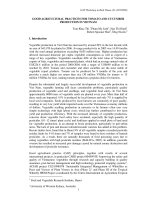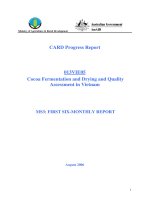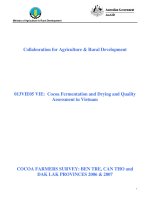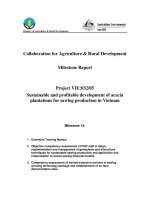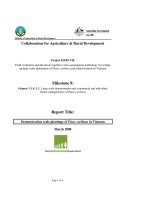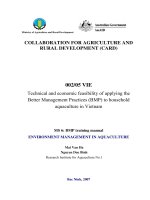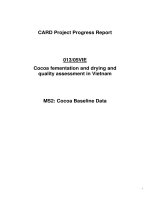Collaboration for Agriculture & Rural Development: Cocoa Fermentation and Drying and Quality Assessment in Vietnam "MS8 pdf
Bạn đang xem bản rút gọn của tài liệu. Xem và tải ngay bản đầy đủ của tài liệu tại đây (83.26 KB, 15 trang )
Ministry of Agriculture & Rural Development
Collaboration for Agriculture & Rural Development
013VIE05 VIE: Cocoa Fermentation and Drying and Quality
Assessment in Vietnam
MS8: Progress Report
Milestone 8: Objective competency assessment of Can Tho, NLU and WASI staff in:
• Design, installation and advice for the use of farmer appropriate drying and
fermentation equipment.
• Skills in establishment and management of taste panels, cocoa sensory analysis
and biometry procedures.
• Analysis and reporting of on-farm trials in Ben Tre, Western Highlands and
Success sites, including farmer oriented financial analysis of cocoa quality
improvement interventions.
Table of Contents
1. Institute Information ___________________________________________________ 1
2. Project Abstract _______________________________________________________ 2
3. Executive Summary ____________________________________________________ 2
4. Introduction & Background _____________________________________________ 5
5. Progress to Date _______________________________________________________ 6
5.1 Implementation highlights_________________________________________________ 6
5.2 Smallholder benefits______________________________________________________ 6
5.3 Capacity Building ________________________________________________________ 9
5.4 Publicity________________________________________________________________ 9
5.5 Project Management _____________________________________________________ 9
6. Report on Cross-Cutting Issues__________________________________________ 10
6.1 Environment ___________________________________________________________ 10
6.2 Gender and Social Issues _________________________________________________ 10
7. Implementation & Sustainability Issues ___________________________________ 11
7.1 Issues and Constraints ___________________________________________________ 11
7.2 Options________________________________________________________________ 11
7.3 Sustainability___________________________________________________________ 11
8. Next Critical Steps ____________________________________________________ 12
9. Conclusion __________________________________________________________ 12
10. Statutory Declaration___________________________Error! Bookmark not defined.
1
1. Institute Information
Project Name
013VIE05 Cocoa Fermentation and Drying and
Quality Assessment in Vietnam
Vietnamese Institution
Can Tho University
Vietnamese Project Team Leader
Dr. Ha Thanh Toan
Vietnamese Institution
Nong Lam University
Vietnamese Project Team Leader
Dr. Pham Hong Duc Phuoc
Vietnamese Institution Western Highlands Agro-forestry Science & Technical
Institute
Vietnamese Project Team Leader
Dr. NGUYEN VAN THUONG
Australian Organisation
QDPI&F
Australian Personnel
Neil Hollywood
Date commenced
February 06
Completion date (original)
February 08
Completion date (revised)
June 08
Contact Officer(s)
In Australia: Team Leader
Name:
Neil Hollywood
Telephone:
617 34068643
Position:
Senior Microbiologist
Fax:
617 34068699
Organisation
QDPI&F
Email:
In Australia: Administrative contact
Name:
Michelle Sinn
Telephone:
617 33462711
Position:
Senior Planning Officer
Fax:
617 33462727
Organisation
QDPI&F
Email:
In Vietnam
Name:
Ha Thanh Toan
Telephone:
84 71 830604
Position:
Director, Biotechnology R&D
Institute
Fax:
84 71 830604
Organisation
Can Tho University
Email:
2
2. Project Abstract
3. Executive Summary
During this period the last of fermentation trial results from Nong Lam University were
received and write up of fermentation and drying trials completed. This allowed
completion of the farmer’s manual regarding recommended procedures for processing of
cocoa post harvesting i.e. pod storage, fermentation procedures and manipulations and
drying procedures. These results have been reported in milestone reports five and seven.
• Design, installation and advice for the use of farmer appropriate drying and
fermentation equipment.
The final recommendations, regarding dryer design and materials to be used, were
completed in August 2006. This was the time of the QDPI& F Engineer’s visit. Since
then, seven dryers have been prefabricated at Can Tho University. These were then
transported to different farmer sites. Three have been erected in Ben Tre, two has been
erected in Dak Lak, one has been erected in Can Tho and one erected at Nong Lam
University. Performances of the dryers have been tested at each of the participating
Vietnamese Institutes. Similarly, fermentation boxes of four different capacities (100kg,
50kg, 25kg and 10kg) were also supplied to each farmer. As well as box fermentations,
heap fermentations have been conducted and recommended in the farmer’s manual.
Recommendations regarding fermentation and drying procedures have been presented
previously in the farmer’s manual as an attachment to milestone 5. The manual is
currently undergoing a revision of its format, prior to printing.
The Government of Vietnam is focusing on high quality Vietnamese cocoa and
has set a goal of having 10,000 ha of planted cocoa by 2010. This is principally
aimed for in the Central Highlands and Mekong Delta regions. These are priority
regions for CARD projects. It is crucial that Vietnam produces a high quality
fermented cocoa that would improve incomes for Vietnamese farmers. The best
way to assure good quality attributes is to train relevant Vietnamese organisation’s
staff in assessment of cocoa quality and fermentation and drying methodologies.
The obvious choice for training are scientists from the Vietnamese Cocoa
Development team in Nong Lam University, scientists from Can Tho University,
and WASI, the official cocoa research institute, in Dak Lak province. In this
project, smallholder methods of fermenting and solar drying cocoa are to be tested
under Vietnamese conditions and factors involved in farmer adoption.
Methodologies will be passed to farmers through extension and other appropriate
channels. In tandem with this, training of Vietnamese staff in cocoa sensory and
chemical analysis at QDPI&F, is to be conducted. The aim of these project
activities is to produce high quality cocoa as well as having the capacity to
monitor and advise at the participating Vietnamese Institutes.
3
• Skills in establishment and management of taste panels, cocoa sensory analysis
and biometry procedures.
All of these factors were covered during the training of Vietnamese staff, from each
participating Vietnamese Institute, at QDPI&F during July 2006. Nong Lam University
already had a cocoa grinder and WASI was supplied with one as per the budget. Can Tho
university has been supplied with a “kitchen appliance” type grinder which is satisfactory
for the production of both chocolate and cocoa liquors. The institutes therefore have the
training and equipment to conduct taste panels, cocoa sensory analysis and biometry
procedures.
• Analysis of on-farm trials in Ben Tre, Western Highlands and SUCCESS
Alliance sites, including farmer oriented financial analysis of cocoa quality
improvement interventions.
On-farm trials
Analysis of on-farm trials and drying rates was conducted by staff from all three
Vietnamese Institutes and presented in milestone seven. However, none of the
participating institutes are close enough to cocoa growing areas to conduct the full range
of analytical tests that are required for proper assessment of fermentation and drying
parameters. Analysis was basically restricted to getting farmers to measure the
temperatures of fermentation times and length of time for drying, either with or without a
solar dryer and then doing analyses on dried bean samples.
Farmer oriented financial analysis of cocoa quality improvement interventions
The full analysis of the farmer surveys conducted before and after the installation of solar
dryers at smallholder sites is presented as an attachment.
Summary of findings
An initial survey of farmer practices, time, labour, costs and income had been conducted,
in Ben Tre Province, in August 2006. This survey was conducted to establish baseline
figures for production, income, time & labour inputs etc and involved interviewing fifty
farmers. The basic findings were reported in the milestone 2 report in December 2006.
Following this initial survey, three farmers, in Ben Tre province, were supplied with solar
dryers in the second half of 2006. A follow up survey was conducted in December 2007.
This survey consisted of twenty five farmers from the original 2006 survey, two of whom
had been supplied with a solar dryer and an additional twenty five new farmers not
included in 2006. One of these new farmers had been supplied with solar dryers. The
effect on the income of farmers is summarised below and presented in detail in the
farmer’s survey attachment. One problem with the survey is that farmers were usually not
able to give accurate production figures as records aren’t kept. Records are generally not
kept for income either. For both production and income figures, it was usually the case
that farmers could only give estimates or not answer the questions for these and other
factors. In cases where production figures were given, but not income, the income had to
be calculated on pod production & purchasing figures. This is gone into in some detail in
the survey attachment.
4
During this reporting period, surveys of cocoa producing farmers in Can Tho, Dak Lak
and Dak Nong provinces were completed. There is only one substantial cocoa grower in
Can Tho province and this farmer was provided with a solar dryer in 2007. Because of the
distances (>60km) of farmers from Western Highlands Agricultural Science Institute
(WASI) a survey was only conducted on a total of six farmers in Dak Lak and Dak Nong.
One of the farmers had been supplied with a solar dryer in December 2006. The findings
for these provinces are similar to those of Ben Tre which is summarised as follows:
In Ben Tre Province there were three recipients of solar dryers. The first was a Mrs Nam
Suong at An Phu, An Khanh, Chau Thanh. She is a farmer who has a 0.25ha farm planted
with two hundred trees and therefore had little capacity for cocoa production of her own.
She had set herself up as a pod buying point before the initial survey and was fermenting
and drying beans from purchased pods as well as her own. In the year prior to August
2006, she was producing and/or buying around 2500kg per annum for a cost of VND51M.
After fermenting and drying, she was making an annual income of approximately
VND97M and approximately VND46M profit. Since receiving the dryer, she can now
process much larger quantities of pods and is purchasing approximately three thousand
kilos of pods per week in the main harvest period and approximately 400kg of pods per
week in the remainder of the year. The purchase of these pods costs her VND104M. After
fermenting and drying, she makes an annual income VND285M. Therefore she is now
making an annual profit of VND182M. She has also reported a reduction in drying times
and associated labour from 6-8 days to 3-5 days in the dry season and from 9-11 days to 6-
8 days in the wet season. Therefore, she has not only increased her capacity to process the
crop and income from it, but also reduced processing times and associated labour by three
days.
The second Ben Tre farmer is Nguyen Hung Son and his wife Dinh Thi Kieu of Phu Xuan
Village, Phu Duc, Chau Thanh. They have a farm of one hectare which had 300 trees
planted in 2000 and 600 trees planted in 2003. They were also a pod buying point prior to
being given a solar dryer. In both 2006 and 2007 they gave an estimated annual income of
VND100M. From their pod production figures, VND42M in 2006 and VND55M in 2007,
would have been from their own crop. The remainder would have come from purchased
pods which approximately double in value, after fermentation and drying. They have got
an increased capacity for processing crop and have reported reductions in drying times and
associated labour of 1-2 days in the dry season and 2-4 days in the wet season.
The third recipient in Ben Tre was Nguyen Thanh Phuong and his wife Ho Thi Hong Hue.
They had a one hectare farm which had been planted with 400 trees in 2005 and 150 trees
in 2006. The 400 trees planted in 2005 would have been coming into production at the
time of the survey in 2007. He also has an increased capacity to ferment and dry cocoa
and processes 500kg of pods per week during the peak season. He has not given estimates
for income, but that amount of cocoa would translate to VND93M annually when sold as
fermented dried beans. He was receiving VND27,000/kg dried beans from Cargill in
December 2007. As of June 2008, prices for cocoa are VND 36-38,000 per kilo and the
same crop would have earned him VND127M. He reported reductions of three days in
drying time and associated labour for the dry season and two days in the wet season.
With quality attributes of cocoa, there has not been any perceivable change due to the
introduction of solar dryers. In Ben Tre, Dak Lak, Dak Nong and Can Tho provinces, the
5
weather is such that there are negligible losses of cocoa or detrimental flavour effects,
from mould contamination, during standard sun drying. All farmers reported < 1% loss of
cocoa to mould contamination using traditional drying methods. What the solar dryers
have done is to increase the capacity of farmers to dry fermented cocoa and, at the same
time, reduce drying time and associated labour. As well, no time is spent shifting drying
trays under cover at night or during periods of rain and this represents a significant time
and labour saving. Therefore farmers with a solar dryer have got an increased capacity to
grow or purchase other farmers crop for processing combined with an ability to reduce
drying times and labour. The use of sun dryers can only be said to maintain quality
standards while processing larger volumes.
The main impact this project could have on quality attributes is through adoption of
recommendations regarding fermentation procedures as presented in the fermentation
trials and manual reported in milestones five and seven. As it turned out,
recommendations regarding fermentations were only finalised in March 2008. There has
not been time to introduce them to farmers and then gauge an effect on quality attributes.
There is every reason to believe that adoption of the fermentation recommendations would
improve quality but another six month period would be required to establish that.
4. Introduction & Background
Cocoa production is focused the Mekong Delta in Vietnam with new goal 10,000 ha of
cocoa planted by 2010.
The overall objective of the project is that Vietnam can produce high quality fermented
cocoa and then in-turn to increase cocoa growing farmer’s income.
The Specific Project Objectives are:
1. Capacity building of three selected Vietnamese Institutions to assess cocoa quality;
2. Establishment of sensory laboratories, trained sensory panels and install software
packages for analysis at all three participating institutions;
3. Training on analytical aspects of cocoa quality in Australia-QDPI&F for one scientist
from Can Tho University and from Nong Lam University due to their existing
analytical capacity;
4. Optimisation of fermentation practices for small farmers;
5. Introduction of solar drying technology to two selected Vietnamese institutions;
6. Extension of methodologies to small farmers;
To achieve this objective, the approach is to develop, test and extend techniques in quality
assessment at the institutional level and to develop appropriate smallholder processing and
quality assurance methodologies.
Milestone 8 is defined as Objective competency assessment of Can Tho, NLU and WASI
staff in:
• Design, installation and advice for the use of farmer appropriate drying and
fermentation equipment.
• Skills in establishment of taste panels, cocoa sensory analysis and biometry procedures
• Analysis and reporting of on-farm trials
6
5. Progress to Date
5.1 Implementation highlights
The activities listed are as per the project document as this states the activities in more
detail than the amended contract.
Objective competency assessment of Can Tho, NLU and WASI staff including:
• Skills in establishment and management of taste panels, cocoa sensory analysis
and biometry procedures.
Objectives 3, 4 & 6:
Activity 3.1: Training in sensory, analytical and biometry procedures at QDPI&F for
Vietnamese staff from Can Tho, Nong Lam and WASI.
This took place in August 2006 and associated training notes provided. Nong Lam
University nominated a student already in Brisbane, thus saving an airfare. This airfare
was then used to bring a staff member from WASI. The following staff attended the
course; Pham Van Tho from WASI, Nguyen Van Than from CTU and Tuyen-Thuc
Truong from NLU. The staff members from CTU and WASI did not have previous
training in sensory evaluation. Tuyen-Thuc had attended a course at NLU, “Sensory
Evaluation of Cocoa” in September 2004 & a course “Food Sensory Evaluation” in March
2004 at the University of Technology, HCMC.
Activities 3.2: Training on cocoa sensory, biometry and analytical procedures by
Australian collaborators for scientists from Can Tho, WASI and NLU.
The staff received training in sensory analysis, establishment of taste panels and
associated biometry. In addition, training was conducted in the use of High Performance
Liquid Chromatography (HPLC) for analysis of organic acids in cocoa and Gas
Chromatography-Mass Spectrometry - Olfactometry (GC-MS-O) for identification of
volatile compounds and their aromas, associated with cocoa flavour and aroma. Cocoa
samples from Can Tho, Ben Tre and WASI, were analysed and subjected to sensory
evaluation. Samples from West Africa, Malaysia, Indonesia and Papua New Guinea were
also included for comparative purposes. Reports of this visit have been previously
presented in Milestone report 4 (2
nd
six monthly report). An attachment (2), regarding this
training, is provided.
Activity 3.3: Establishment of sensory, analytical and biometry procedures at Can
Tho, WASI and NLU.
Further industry consultation, regarding Vietnamese cocoa quality and how the project can
address issues, was also pursued during this visit. A cocoa quality workshop, organised by
SUCCESS Alliance (SA) and MARS, at Nong Lam University was attended by the
Australian collaborator during his visit in April 2007. He also gave a presentation on
cocoa fermentation and drying and quality aspects of cocoa at this workshop.
7
Activity 4.1: Assistance to Can Tho, NLU and WASI in buying the equipment
required for sensory, analytical and biometry procedures.
Can Tho University
A liquoring machine for CTU was not budgeted for in the project but an alternative
cheaper machine which would produce liquors was found. This was a “kitchen utensil”,
mortar and pestle, produced for grinding herbs and spices to a powdered form. It was
found to produce satisfactory liquors and chocolate. CTU therefore, now has trained staff
and the equipment for making cocoa liquor and chocolate samples.
Western Highlands Agricultural Science Institute
A cocoa liquoring machine was delivered to Vietnam in September 2006 and forwarded to
WASI in time for the Australian collaborator’s visit in December that year. Liquor
production and tasting sessions were then conducted under supervision by the Australian
collaborator during visits between December 2006 and April 2007.
Nong lam University
NLU already had a liquoring machine, taste panel booths and equipment required to
conduct sensory analysis prior to this project.
Activity 6.1: Training of WASI staff at Can Tho, WASI and NLU in sensory
analytical and biometry.
Western Highlands Agricultural Science Institute
Follow-up training was conducted on cocoa sensory and quality assessment during the
collaborator’s visits between December 2006 and April 2007. The first samples of liquors
were made at WASI during the Australian collaborator’s visit in December 2006 and
preliminary taste panels conducted. In addition to Pham Van Thao being trained at
QDPI&F, WASI has two staff members, Ms Ho Thi Phuoc and Ms Dao Thi Lam Huong,
who have received training in sensory work at an institute in Hanoi at a previous time.
Liquor samples were manufactured and tasting sessions conducted during several visits by
the Australian collaborator. In addition to WASI staff, a representative, Cao Xuan Loc, of
DAK MAN, a cocoa exporting company, was present at tasting sessions in December
2007 and April 2008. He gave samples of cocoa that they were prepared to pay premiums
for, as per the requirements of European companies they were exporting to. With the
presence of three trained staff, a cocoa liquoring machine and advice from industry
regarding their requirements, cocoa sensory capabilities at WASI have been well
established and staff are familiar with desired cocoa flavour attributes for the region.
Nong Lam University
Tuyen-Thuc Truong had attended a course at NLU, “Sensory Evaluation of Cocoa” in
September 2004 & a course “Food Sensory Evaluation” in March 2004 at the University
of Technology, HCMC, before attending the training at QDPI&F. She is well acquainted
with sensory procedures and biometry. At NLU, a well established sensory panel did exist,
prior to this project run by Lam Thanh Hien. With training in sensory evaluation of cocoa
being completed, NLU has the capacity of comprehensive sensory evaluation of cocoa and
has conducted sensory evaluation of samples produced in fermentation trials at NLU.
Can Tho University
Nguyen van Thanh attended the sensory training at QDPI in August 2006. CTU did lack a
liquoring machine but this was later rectified by purchasing a cheap alternative. With the
8
training at QDPI&F and a liquoring machine Can Tho University now has the capacity to
conduct sensory evaluation of cocoa.
• Design, installation and advice for the use of farmer appropriate drying and
fermentation equipment.
Project objective 10:
Activity 10.1: Confirmation of most suitable fermentation and drying practices at
Can Tho, NLU and WASI.
This component was completed in February 2008 and a manual produced (milestone 5)
which has been presented previously. This report is now being re-formatted. With the
conduct of fermentation and drying trials, each of the institutes is fully equipped and
trained to perform the analyses required. These trials, largely conducted by staff at CTU,
NLU & WASI have been presented in detail in milestone 7. Also each Institute has been
supplied with a solar dryer. In Can Tho a farmer Mr Nam Vinh has been supplied with a
solar dryer and he is within a short travelling distance from Can Tho University. Ben Tre
province has three farmers who received a solar dryer. Dak Lak Province has one farmer
supplied with a solar dryer. In total, eight solar dryers have been supplied during the
project.
• Analysis and reporting of on-farm trials in Ben Tre, Western Highlands and
SUCCESS sites in Ben Tre.
Project objective 14:
Activity 14.1: Information gathered regarding progress of field trials
Field trials have been reported in the fermentation and drying trial report (attachment to
milestone 7).
Activity 14.2: Information gained for inclusion in final report and recommendations made
regarding problems encountered with smallholder and cooperative adoption.
These issues have both been addressed in the Farmer survey document attached.
5.2 Smallholder benefits
Cocoa, properly fermented and dried, and of good flavor attributes, can fetch a premium
between 100-200 USD/tonne over the usual Southeast Asian bean price. This means that,
if this project were successful in establishing a high quality standard, Vietnamese
smallholders would earn an additional 1-2 million USD per year once the foreseen target,
of 10,000 ha in production by 2010, is reached. For the Mekong Delta region, there is the
potential of an additional amount of 1.8-3.6 million USD that would be earned by
smallholder cocoa growers. Due to similar rainfall, development of methodologies for the
Mekong should be transferable to the Central Coast if cocoa production was initiated
there.
A short survey of cocoa farmers at Ben Tre province, by SA in 2004, demonstrated that
cocoa trees, within 2 years of planting, could give 50kg of cocoa bean per month/ha. The
yield increases to 200kg cocoa bean/month/ha for 4 year old trees. At the present price
(VND21000/kg of fermented bean) farmers could earn 3.6 billion Vietnamese
Dong/month/ha (or 235 USD/month/ha) for good quality cocoa.
9
Since writing the project proposal, the price of fermented dried beans has increased to
VND38000 per kilo and income from the crop has improved accordingly.
The impacts, of adoption of methodologies from this project, are reported in detail the
farmer survey attachment.
5.3 Capacity Building
Training in the conduct of fermentation and drying trials and analysis of the relevant
parameters has now been completed at each participating institute.
Training, in the use of HPLC for organic acids and GC-MS for aromatic compounds, for
Vietnamese staff from each participating Institute, was conducted at QDPI&F in August
2006. Of the participating institutes, only NLU has the equipment for conduct of these
analyses.
Training in sensory evaluation and biometry of results was also conducted at this
workshop. Follow up training has been conducted by the Australian collaborator during
visits in December 2006 and April 2007. A mortar and pestle, for cocoa liquor or
chocolate production, has been delivered to WASI and a processor for chocolate or liquor
production delivered to CTU. NLU had equipment for this prior to the project
commencement.
5.4 Publicity
The following has been applied to publicise AusAID / CARD involvement.
• References and signage at field demonstrations, workshops and training sessions (Solar
dryers and fermenting boxes demonstrated in Ben Tre Province during an “International
Cocoa Workshop” Nov. 2006 and a seminar on cocoa fermentation& drying and quality
assessment given by the Australian collaborator, at a cocoa workshop at Nong Lam
University (NLU) in April 2007)).
• References in training manuals.
• Project publication appeared in World Cocoa Foundation Newsletter.
5.5 Project Management
The Vietnamese Institutes is responsible for the bulk of planning and conduction of
fermentation and drying trials as well as sensory and analytical work post training. The
Vietnamese institutes would also be responsible for the monitoring of trials and impact on
farmers work load and income and the quality attributes of cocoa from the farmer trials.
The Australian Institute would collaborate in the monitoring, analysis of data generated,
production of extension materials and reporting of the project. The Australian Institute
also manages the project budget.
10
6. Report on Cross-Cutting Issues
6.1 Environment
Cocoa growing can have fewer adverse effects on the environment than other forms of
agriculture. Production blocks are often small, with cocoa grown as a mixed crop with
coconuts or a variety of subsistence food crops. Research papers, including presentations
at an ICCO conference (Brazil, 1996), report that species diversity, including mammals,
birds, insects etc on cocoa blocks, may be similar to that of adjacent rainforest in cocoa
growing areas.
Environmental risks involved in the program are therefore, regarded as minimal. The
project involves processing of existing and future plantings of cocoa. Future plantings may
impact on natural flora and fauna but the program is not related to any expansion of areas
under cocoa cultivation. Cocoa is also considered an environmentally benign crop. In the
Mekong Delta, cocoa is planted in mixed planting systems, mainly with coconut but also
in very diversified systems with as much as up to 15 different species of fruit trees, nut
trees, shrubs, vines and medicinal plants with a resultant, very high biodiversity.
6.2 Gender and Social Issues
Many cocoa farmers in Vietnam already ferment and dry their own cocoa and therefore
have some experience with these practices. During the field trials on optimisation of
fermentation techniques, an attempt would be made to incorporate the better aspects of
what is currently done into our recommended methods. This incorporation would take into
account materials currently used and environmental, work practice, and social factors.
A Success Alliance study, in 2005, has demonstrated the following:
SA has four participating provinces of Binh Phuoc (1095 households), Ba Ria Vung Tau
(1560), Tien Giang (1600) and Ben Tre (1679). In these provinces, female participation
varied from 9% in Binh Phuoc to 20% in Ben Tre. Tien Giang had 16% and Ba Ria Ving,
13%.
Virtually all of these participants had farming as their sole income. The bulk of
participants are in the age range of 26-55 which is considered an experienced labour age.
The bulk of participants had a median family size of 3-5 members. The percentage of
farmers with an education level of secondary to high school varied from 69-77% across
the provinces, therefore with this level of education, a high percentage of uptake of
knowledge could be expected.
In Binh Phuoc province 90% of farmers had an income between VND 12-100M per
annum for all crops grown. The median figure was VND 40M. In Ba Ria Vung Tau the
figures were 90% having income between VND1-45M, with a median level of VND17M.
In Ben Tre 90% of participants had incomes between VND1-10M and a median income of
VND 4M. In Tian Giang 90% had an income between VND 2-10M and median income of
VND 5M. In Can Tho province the only substantial cocoa grower had an annual income
of VND 16M from cocoa alone.
The farmer survey, conducted for this project, has been completed and is presented as an
attachment.
11
7. Implementation & Sustainability Issues
7.1 Issues and Constraints
One concern was that the solar driers would not suit smallholders due to price and
complexity issues. However it was regarded that simple units could be built to suit
smallholder purposes. After the visit by the QDPI&F drying specialist, prices and
availability of different materials for dryer construction were compared. Wooden frames
were found to be the same price as those constructed with square, tubular steel, galvanized
iron. The iron frames are preferred as they do not rot or warp with time as timber frames
do. However the smallest sized dryers, capable of drying 100-150kg wet beans cost
around VND3.2M. This has since been overcome with the sourcing of a cheaper type of
plastic sheeting currently available in HCMC. The Israeli polycarbonate sheets, used in
the project, cost about VND1.2M each and two sheets were required for a 4sqM drying
bed, capable of taking 200kg wet beans. Apart from the cost, there was no retail outlet for
these sheets in Vietnam. With the cheaper sheets available in Vietnam, costs have come
down to VND1.6M for a dryer with a drying bed 2M x 2M. Contacts have now been made
between the Australian distributor and some companies in Vietnam. It’s hoped that, by the
end of the project or after that these sheets will be available at retail outlets.
It has also been noted during drying trials, that the recommended bed loading rate of 50kg
wet beans per sq M was an underestimate of their drying capacity. This figure had been
arrived at based on results from a province in Papua New Guinea which has higher rainfall
than the Mekong Delta region. Results demonstrate that beds can be loaded up to 100kg
per sq M in the dry season. This means that a 2M x 2M drying bed has the capacity to dry
400kg wet beans in 4-5 days. This represents a huge improvement in the capacity of
farmers to process cocoa at a reasonable capital outlay. This is further expanded on in the
farmer survey attachment.
Work conducted has shown that the practices of pod storage, spreading of beans prior to
placement in fermenting boxes and washing, prior to drying, does improve the quality of
cocoa. All these practices can be easily conducted by farmers and are described in detail in
the farmer’s manual attached to milestone five.
7.2 Options
All procedures mentioned above have now been adequately tested and incorporated into
the farmers manual.
7.3 Sustainability
The trials already conducted at Can Tho plus the extensive training in dry bean analysis by
permanent staff from CTU, NLU and WASI means that the project has a high degree of
sustainability.
Also with the training in sensory evaluation in Brisbane, the delivery of equipment, and
follow up training by the Australian collaborator means that this aspect of the program
will have sustainability.
12
8. Next Critical Steps
The next critical steps are given as per the project document activity schedule:
Objective 7: Validation of smallholder benefits.
The necessary data, from the farmer’s 2006 initial survey and follow-up survey in 2007
has been collated and the report is to be finished shortly.
Objectives 15, 16, 17 & 18: Project completion report.
Activity 15.1: Results are established for final project workshop and final project report.
Activity 16.1: Final assessment of trials and activities for presentation at final project
workshop in December 2008.
Activity 17.1: Presentation of project achievements at final workshop attended by Can
Tho, NLU, WASI, SUCCESS and another interested agencies.
For activities 15.1, 16.1 & 17.1, the conduct of trials and presentation of results has been
completed but behind schedule. Due to lateness in delivery of milestones and subsequent
payments, a final project workshop can not be conducted before the project completion
date. Unless some way is found to allocate funds for the conduct of a project workshop
post 30
th
June, activity 17.1 can not be held.
Activity 18.1: Final recommendations and project completion report written
This will be completed by December 2008.
9. Conclusion
Finalization of the fermentation trials became behind schedule for a number of reasons
including a need to replicate some trials conducted in Dak Lak, in the Mekong region and
delays in sensory evaluation. Conduction of some fermentation trials were also delayed
because of the fact that cocoa is a seasonal crop and sufficient quantities of pods are not
available at all times of the year. An example of this is that the last project trial conducted
at NLU in December 2007 was performed using pods that had been transported from Dak
Lak. It would have required waiting several months for ripe pods to become available at
NLU. However the results of fermentation trials conducted have produced several new
recommendations regarding fermentation procedures that have been demonstrated to
benefit cocoa quality and can be easily conducted by farmers.
Effective recommendations can be made, but this delay in finalising the fermentation trials
has resulted in a delay in completing extension material, which in turn has delayed
dissemination of information to farmers and extension officers within MARD and DOST.
It has also delayed on-farm trials using all of the final recommendations and an
assessment of their impact on farmer livelihoods.
Project activities, especially as regards on-farm trials, monitoring of farmer practices and
assessment of adoption of recommendations on cocoa quality, have additionally been
hampered by the fact that in Can Tho Province, where the lead Vietnamese Institute is
located, only one significant cocoa grower exists. The nearest Province, where substantial
plantings and numbers of farmers exist, is Ben Tre Province which is eighty kilometres
from Can Tho. This wasn’t known to the Australian counterpart at the stage of writing the
proposal and staff time and funding for monitoring on-farm trials, farmer practices &
13
collection of samples for assessment over this distance was not written into the proposal or
budget.
It is now apparent that, to have a final workshop, on the findings to date, would mean that
it would have to be held post the project completion date.
